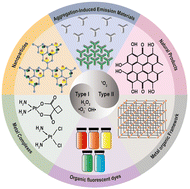A type I and type II chemical biology toolbox to overcome the hypoxic tumour microenvironment for photodynamic therapy
Abstract
Photodynamic therapy (PDT) is a minimally invasive therapeutic modality employed for the treatment of various types of cancers, localized infections, and other diseases. Upon illumination, the photo-excited photosensitizer generates singlet oxygen and other reactive species, thereby inducing cytotoxicity in the target cells. The hypoxic tumour microenvironment (TME), however, poses a limitation on the supply of oxygen in tumour tissues. Moreover, under such conditions, tumour metastasis and drug resistance frequently occur, further compromising the efficacy of PDT in combating tumours. Traditionally, type I photosensitizers with lower oxygen consumption demonstrate significant potential in overcoming hypoxic environments and play a crucial role in determining the therapeutic efficacy of PDT because type I photosensitizers can generate highly cytotoxic free radicals. In comparison, type II photosensitizers exhibit high oxygen dependence. The rate of reactive oxygen species (ROS) generation in the type II process is significantly higher than that in the type I process. Thus, the efficiency and selectivity of PDT depend on the properties of the photosensitizer. Here, the recent development and application of type I and type II photosensitizers, mainly in the past year, are summarized. The design methods, electronic structures, photophysical properties, lipophilic properties, electric charge, and other molecular characteristics of these photosensitizers are discussed in detail. These modifications alter the microstructure of photosensitizers and directly impact the results of PDT. The main content of this paper will have a positive promoting and inspiring effect on the future development of PDT.

- This article is part of the themed collection: Biomaterials Science Recent Review Articles, 2024


 Please wait while we load your content...
Please wait while we load your content...